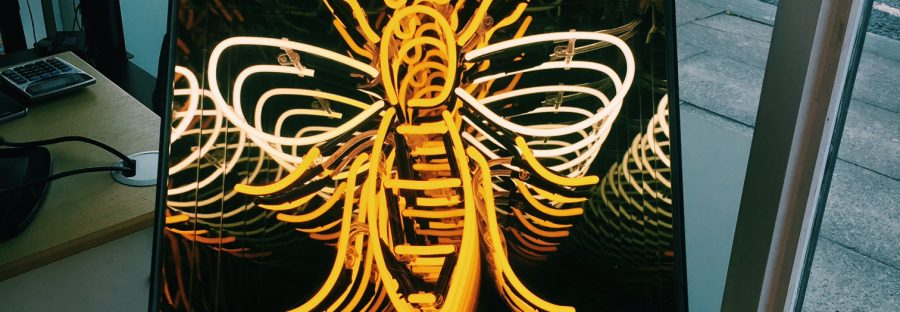Manchester exhibition shines a light on neon artwork
- Dazzling display of neon creations from artist Tony Spink
- LIGHT | TOUCH Exhibition at Artzu Gallery now open to the public
- Footballer Peter Crouch among celebrity fans
A display of dazzling neon signs was unveiled at a Manchester art gallery on Thursday.
Tony Spink, owner of Bolton-based design studio Neon Creations, has collaborated with resin based artist Stephen Farley for the LIGHT | TOUCH exhibition at Manchester’s Artzu Gallery.
Tony has been working with neon for almost 30 years. He was born and bred in London, but moved to Manchester in 2001 to be with his wife and business partner Catherine.
Together, they have created a range of neon signage for branding, events, entertainment, art and domestic use.
Their client base includes footballer Peter Crouch, restaurant chain Solita, clothing company River Island and singer Lucy Spraggan – who performed at the VIP opening night of the exhibition.
Catherine Spink, co-founder of Neon Creations, said: “Our aspirations for the company are to continue with our standard commercial work, where customers provide us with a specification of what they want, but also for Tony as an individual to develop more on the neon art side of things, where he is coming up with his own ideas.
“Tony has always worked in the sign trade since leaving school at 16. He saw an advert for an apprentice neon glass bender, went for the interview, got the job, fell in love with neon and never looked back!”

Tony’s creations are produced by heating straight lengths of glass tubing in a flame and bending them into shape. These tubes are then pumped with neon or argon gas, depending on the final colour of the piece.
The firm’s trainee, Sam Beresford, has recently been given more responsibility, which means Neon Creations now has a bigger workforce and a quicker turnaround time on projects.
Catherine said: “One of our greatest achievements is training Sam to become a neon glass bender to a standard where she is now good enough to make high quality pieces that can represent the company.
“Working with neon is a unique skill and you can’t learn it at college. There are quite a few challenges that come with it: not burning yourself on the flame or hot glass, not cutting yourself on broken glass and not messing up complex bends and wasting hours of work. You have to be really committed when you learn this job.”

Neon found its heyday in the early 1900s, but when cheaper plastic and LED signs came along in the 1990s, its usage fizzled out. Now it appears to be making its grand comeback and can be seen in establishments around Manchester.
Catherine added: “We find that different industries use neon during different periods, so whilst it may be popular in the music industry for a time, it may not be popular in the retail industry at that time.
“There will definitely always be a demand for it, as long as the people making it push boundaries and come up with new ideas. Neon has been around for more than 100 years, with very little change in how it is produced – a product that truly stands the test of time.”
The LIGHT | TOUCH exhibition is open to the public until 22 November.


